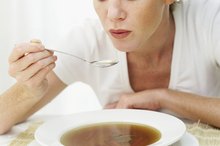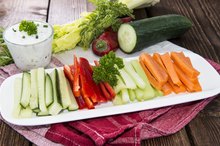Finger Foods for 9-Month-Old Babies
Babies develop rapidly within their first year. When they begin teething, they can graduate from soft to hard foods. Around age 6 months, many babies will cut their first teeth. At 9 months, not all teeth are formed, but babies can slowly be introduced to soft finger foods 12. Because babies are developing their fine motor skills, finger foods help with coordination and introduce them to self-feeding 12. However, some finger foods may still need to be cut into smaller portions to prevent choking 1.
Fruits
Fruits offer a sweet yet healthy treat for older babies around 9 months of age. Fresh fruits are preferred over dried fruits, because they are softer and provide a sweeter taste. Bananas are a healthful choice because they offer potassium and vitamin C. An appropriate serving size is about half a large banana. Slice the banana, and then cut the pieces in half again to form small chunks that the baby can easily pick up. Choose soft fruits, such as peaches and apricots. Cook apples or other tough fruits to achieve a mushy texture that allows babies to grind the food with their gums.
- Fruits offer a sweet yet healthy treat for older babies around 9 months of age.
- Cook apples or other tough fruits to achieve a mushy texture that allows babies to grind the food with their gums.
Vegetables
Diet After a Frenectomy
Learn More
Such vegetables as peas, corn, broccoli and carrots provide niacin in the diet. Most vegetables will need to be cooked or boiled to be acceptable for babies. Peas and corn make entertaining and nutritious finger foods for 9-month-olds 12. Broccoli and carrots should be cooked, cut and sliced into dime-size pieces. They can be mixed or served individually for lunch, dinner or snacks.
- Such vegetables as peas, corn, broccoli and carrots provide niacin in the diet.
- Most vegetables will need to be cooked or boiled to be acceptable for babies.
Crackers
Small crackers are simple and delicious finger foods for 9-month-olds 12. Babies easily chew and swallow small thin crackers, such as saltines or wheat crackers. Little fingers quickly grab graham crackers or miniature cookies. Nine-month-olds who are still teething -- especially those cutting their back molars -- may find comfort in Melba toast.
- Small crackers are simple and delicious finger foods for 9-month-olds 1.
- Babies easily chew and swallow small thin crackers, such as saltines or wheat crackers.
Cereals
Foods That Help Your Braces Not to Hurt
Learn More
Crunchy cereals without milk provide quick grabs for little fingers. Toasted oat cereals are heart healthy, tasty and nutritious. Many brands come in a variety of flavors, such as honey nut, frosted and yogurt-covered flavors. Bite-size shredded wheat are also acceptable finger foods 1. Frosted varieties in assorted flavors may appeal more to little appetites. Many 9-month-olds also enjoy munching on corn puffs and rice cereals.
- Crunchy cereals without milk provide quick grabs for little fingers.
- Frosted varieties in assorted flavors may appeal more to little appetites.
Puffed Snacks
Puffed snacks are tasty treats for 9-month-olds. Cheese or veggie puffs are just the right size finger food for small babies 2. Puffs manufactured specifically for babies and toddlers are generally derived from a cornmeal base. Choose brands that are baked and not fried to provide a healthier, lower-fat alternative to standard salty snacks.
- Puffed snacks are tasty treats for 9-month-olds.
- Choose brands that are baked and not fried to provide a healthier, lower-fat alternative to standard salty snacks.
Related Articles
References
- BabyCenter: Finger Foods
- KidsHealth: Finger Foods for Babies
- Van veenendaal LM, De klerk G, Van der velde D. A painful finger as first sign of a malignancy. Geriatr Orthop Surg Rehabil. 2014;5(1):18-20. doi:10.1177/2151458514522125
- Oetgen ME, Dodds SD. Non-operative treatment of common finger injuries. Curr Rev Musculoskelet Med. 2008;1(2):97-102. doi:10.1007/s12178-007-9014-z
- Prucz RB, Friedrich JB. Finger joint injuries. Clin Sports Med. 2015;34(1):99-116. doi:10.1016/j.csm.2014.09.002
- Christensen T, Sarfani S, Shin AY, Kakar S. Long-term outcomes of primary repair of chronic thumb ulnar collateral ligament injuries. Hand (N Y). 2016;11(3):303-309. doi:10.1177/1558944716628482
- Spies CK, Langer M, Hahn P, Müller LP, Unglaub F. The treatment of primary arthritis of the finger and thumb joint. Dtsch Arztebl Int. 2018;115(16):269-275. doi:10.3238/arztebl.2018.0269
- Deveza LA, Hunter DJ, Wajon A, et al. Efficacy of combined conservative therapies on clinical outcomes in patients with thumb base osteoarthritis: protocol for a randomised, controlled trial (COMBO). BMJ Open. 2017;7(1):e014498. doi:10.1136/bmjopen-2016-014498
- Makkouk AH, Oetgen ME, Swigart CR, Dodds SD. Trigger finger: etiology, evaluation, and treatment. Curr Rev Musculoskelet Med. 2008;1(2):92-6. doi:10.1007/s12178-007-9012-1
- Alla SR, Deal ND, Dempsey IJ. Current concepts: mallet finger. Hand (N Y). 2014;9(2):138-44. doi:10.1007/s11552-014-9609-y
Writer Bio
Julie Boehlke is a seasoned copywriter and content creator based in the Great Lakes state. She is a member of the Society of Professional Journalists. Boehlke has more than 10 years of professional writing experience on topics such as health and wellness, green living, gardening, genealogy, finances, relationships, world travel, golf, outdoors and interior decorating. She has also worked in geriatrics and hospice care.









